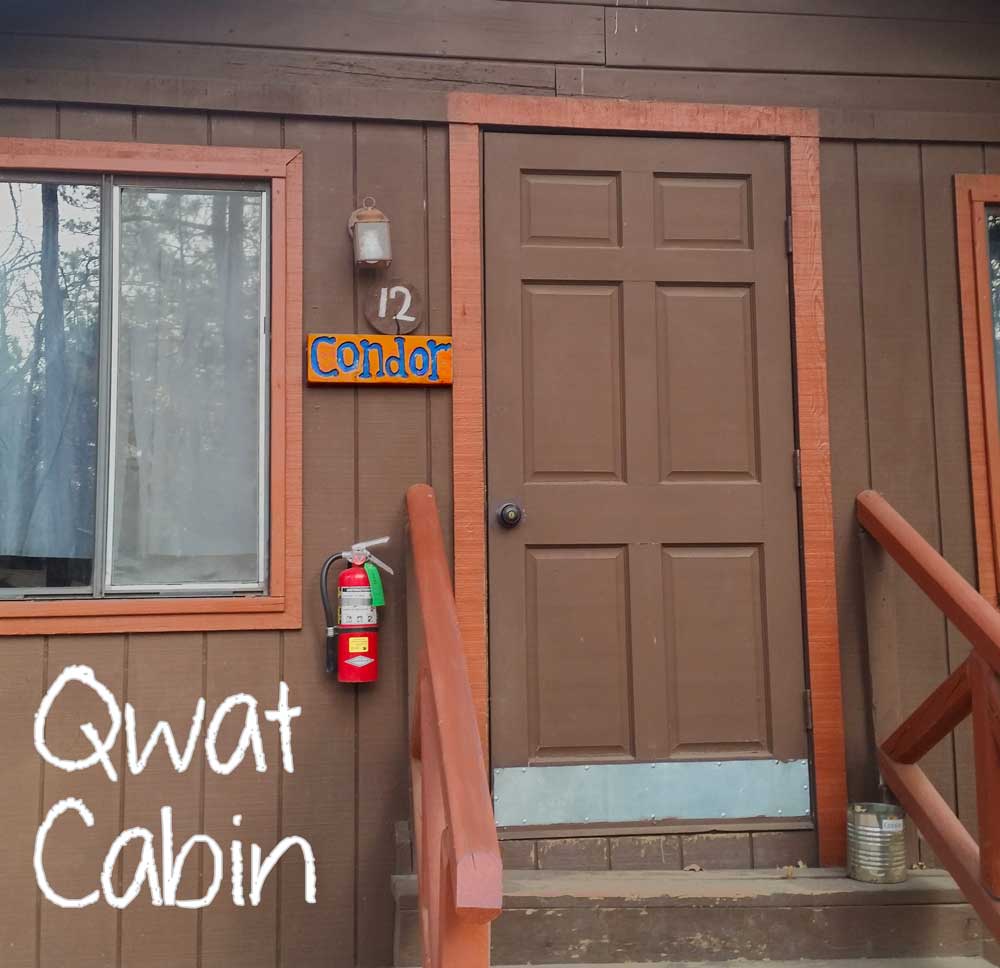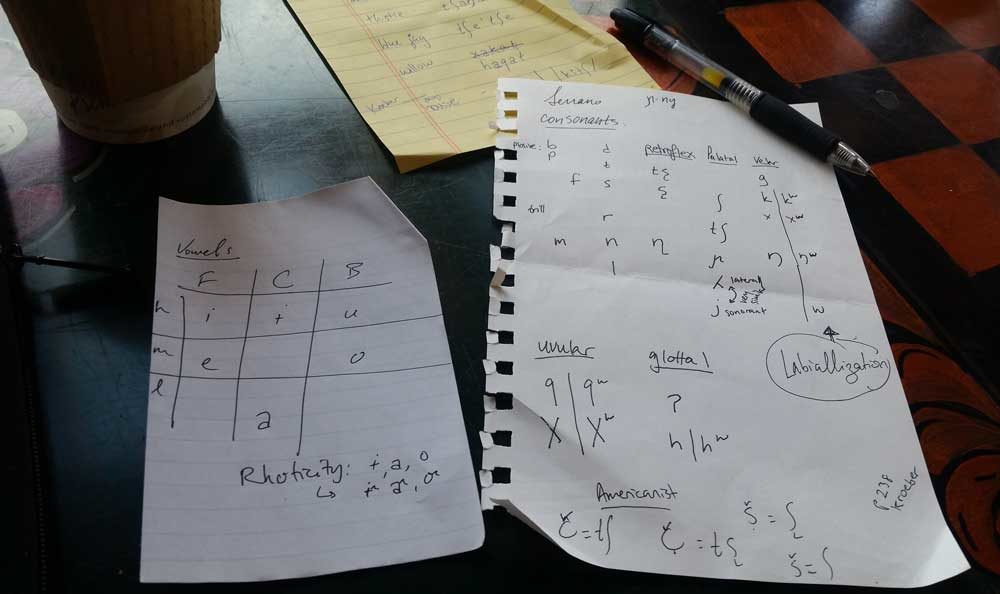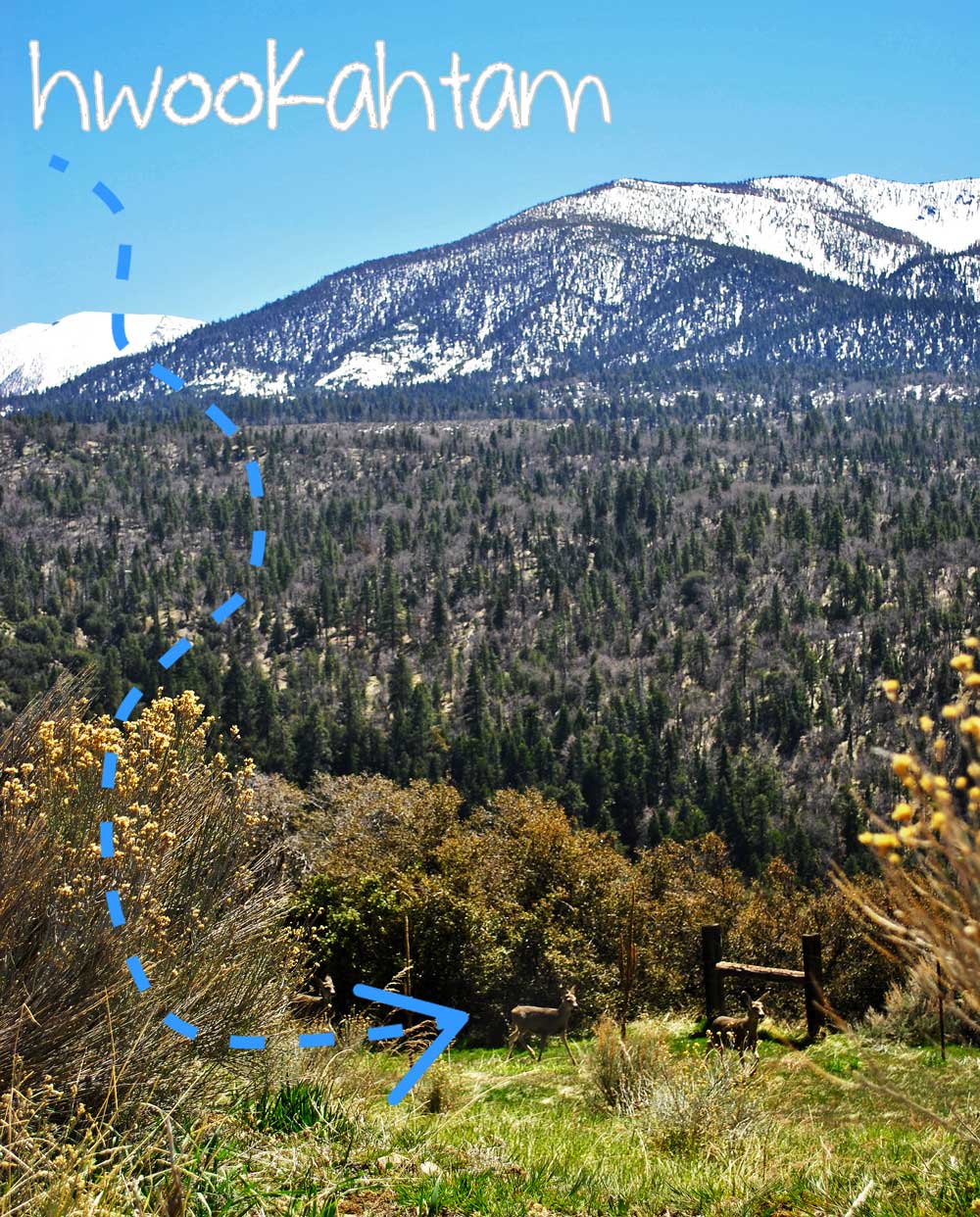You’re staying in the Condor cabin? I think you mean Qwat cabin!

Yuhaviaatam means “people of the pines” in their own language. They are the native peoples who lived on top of our mountain, in the forest that High Trails calls home, long before we lived here. You may have heard them called Serrano, which is the term the Spanish used when they settled and found many tribes in the San Bernadino County area, which seemed interchangeable to them. Serrano actually refers to a handful of these tribes; because they spoke dialects of the same language, their language is usually referred to as the Serrano language.
Quick Yuhaviaatam History
When the Spanish settled in California, they were not particularly accepting of non-Christian religions and non-European languages. Their approach to this perceived problem was to bring native peoples into missions, where they could teach them to be Spanish-speaking Christians and repurpose their labor to use on farms. The Yuhaviaatam, along with the other Serrano tribes, were mostly put into the San Manuel mission, where the vast majority died of smallpox. Europeans had some resistance to this virus brought with them from over the ocean, but the native peoples in North America had no prior exposure to smallpox and it was the primary culprit for the deaths of 90% of the indigenous people on the continent.
While much of the language and culture was lost through the integration into missions and the smallpox epidemic, there are fortunately people today who are of Yuhaviaatam ancestry, people who live and identify as a part of the San Manuel Band of Mission Indians. This picture below is the broad area that a handful of different tribes who make up the Serrano lived in. The Yuhaviaatam would mostly be in that cluster of mountains in the middle, although they came down east into the desert during winter!

The Serrano Language
The last native speaker of the Serrano language, Dorothy Ramon, died in 2002, and there are currently no fluent speakers. The language is now considered in the “awakening” stage of the language life cycle. This means that enough material has been recorded that it’s possible to learn the language, and language revitalization efforts are in place to teach the language. (Check out the Serrano Language Revitalization Program!) Naturally, it’s challenging to learn a language without fluent speakers, and some knowledge has been lost forever, but as long as a decent body of data is preserved, hope remains for the future expansion and evolution of the language.
What do we know about the Serrano Language?
Since the last fluent speaker died in 2002, we can only know what we have preserved. Resources I have been able to find include recordings of Serrano speakers, a complete grammar and several grammar topical papers (but no dictionary), books with English/Serrano translations, and other language learning resources that are open to those who want to take classes and learn the language. Fortunately, if a linguist did a phonological analysis of Serrano with native speakers, and that information is available, we can know pretty closely how each word was pronounced even if we no longer have living native speakers to listen to.

Having a phonology guide can tell us how words are pronounced even without a native speaker.
Learn some of the Serrano language
Here are a couple word lists with pronunciation guides of common nouns. Having common nouns readily available to us is important because when we teach about the Yuhaviaatam or about the region and environment in general, we can integrate these words into our teaching to help paint a more complete, accurate, and respectful picture of the Yuhaviaatam.
The first list is sourced from me listening to recordings (cited below), so any errors in transcription are mine alone. The second list is from A.L. Kroeber’s field notes from 1909. IPA, that weird looking stuff in the middle column, stands for International Phonetic Alphabet and is the tool linguists usually use to write down sounds in a non-ambiguous way, but if that doesn’t make sense to you, you can ignore it and read the English-friendly pronunciation guide on the right.

Ikwe’s transcriptions from Wick R. Miller recordings

Kroeber’s field notes from 1909
Fun Fact: To make Yuhaviaatam words plural, we add -am at the end. It works just like English does for adding -s to the end to make “bear” into “bears” and “crow” into “crows.” For example, Yuhaviaatam, people of the pines, is plural, and the singular form “person of the pines” would be Yuhaviaat. Let’s practice that! If ‘bear’ is hunat, what would ‘bears’ be? …If you said hunatam, you would be correct!

Look at these two hwookahtam (deer, plural) chilling in the forest!
Why do we teach about the Yuhaviaatam at High Trails Outdoor Science School?
At High Trails, we teach about the natural land and it’s connection to our communites. Part of learning about the forest we live in is understanding who was here before us – in particular those who lived in harmony with the earth. Unfortunately, learning about the Yuhaviaatam is an easy topic to gloss over, not because we don’t care, but because there’s relatively little preserved information and it is a challenge that you need a linguist or an anthropologist to dig deep into. It is simply not possible for us to know things that were never written down. As an outdoor school, we try our best to teach what is true, what we can find out from preservation efforts, and be respectful to these people who lived for so long in the pines we now inhabit.
Sources:
- Elicitation of wordlist organized by alphabetically by the Serrano word. Glottal stop – H., LA 130.001, Berkeley Language Center, University of California, Berkeley, http://cla.berkeley.edu/item/15361
- Elicitation of wordlist organized by alphabetically by the Serrano word. H – Kw., LA 130.002, Berkeley Language Center, University of California, Berkeley, http://cla.berkeley.edu/item/15362
- Elicitation of wordlist organized by alphabetically by the Serrano word. L – P., LA 130.003, Berkeley Language Center, University of California, Berkeley, http://cla.berkeley.edu/item/15363
- Elicitation of wordlist organized by alphabetically by the Serrano word. T – end., LA 130.005, Berkeley Language Center, University of California, Berkeley, http://cla.berkeley.edu/item/15365
- Hill, Kenneth Cushman. “A Grammar of the Serrano Language”. University of California, Los Angeles. 1967.
- Notes on the Shoshonean Dialects of Southern California, by A. L. Kroeber, [1909], at sacred-texts.com.
- https://www.sanmanuel-nsn.gov/Culture/Cultural-Overview
- http://www.dorothyramon.org/
At High Trails Outdoor Science School, we literally force our instructors to write about elementary outdoor education, teaching outside, learning outside, our dirty classroom (the forest…gosh), environmental science, outdoor science, and all other tree hugging student and kid loving things that keep us engaged, passionate, driven, loving our job, digging our life, and spreading the word to anyone whose attention we can hold for long enough to actually make it through reading this entire sentence. Whew…. www.dirtyclassroom.com


Comments are closed.